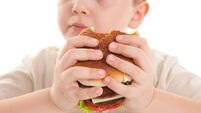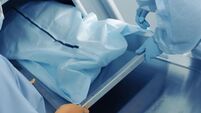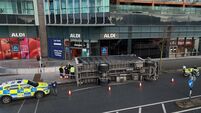Litter levels fall, but it is still plentiful on coastline

Coastal litter caused by drinks containers has halved in one year, but macro and micro debris is still plentiful around the Irish coastline.
Results from 541 survey areas recorded by a team of Coastwatch Ireland volunteers last autumn found continued distribution of abandoned vehicles, girders and machinery, household, construction, fishing, aquaculture and angling litter.
Tyres are not only being dumped, but are also being used to trap peeler crabs for angling bait, particularly along the southern coastline.
Coastwatch Ireland is looking for more information on other trap lines as it says the Government is “set to tackle the problem”.
Green Party South MEP Grace O’Sullivan published the full survey report at an event on board the Brian Boru sailing vessel in Dublin’s Grand Canal Basin yesterday.
The report notes the “most dramatic change” in the Coastwatch survey results 2019 were in the drinks container counts which dropped by 50 per cent on 2018.
“While this is the biggest reduction ever over a year.... a total of 3333 bottles, 2831 lids and 227 tetrapacks is still a lot of drinks related plastic,” it notes.
It must also be borne in mind that figure is only a one visit survey count in 541 survey units. It is a fraction of what is collected in weekly and daily shore cleans all over the island on over 7300 km.
Plastic bottles were recorded on 73% of survey sites as a “peak litter item”.
Metal cans were recorded on 60% and bottle lids on 52% of surveyed shores, the report notes.
“Other” items included cotton bud plastic sticks, followed closely by cigarette butts and wrappers, along with balloons, golf balls, farm plastic and full dog pooh bags.
Tyres were found on 19% of shores and surveyors counted 877 in all. Tyres used to trap peeler crabs for angling competitions or for sale in bait shops were recorded in a number of areas.
“When crabs moult, they are very vulnerable to predation and normally hide under seaweed or stones,” the survey notes.
“If tyres are offered, they appear to prefer these,” the survey notes, but this has a detrimental impact on the local crab population and the trapping is not a licensed activity.
There were 397 records of fishing, aquaculture and/or angling gear, with fishing nets and net pieces the most frequent (38%), followed by aquaculture waste, traps (24% )and angling waste (18% ).
Large aquaculture waste and abandoned gear was found in 8.5% of the sites surveyed in 2019. The items ranged from abandoned broken trestles to long line floats or sorting equipment, and netlon bags and hooks.
Aquaculture litter “hotspots” of Dungarvan spit and Woodstown beach, Waterford in the south east, and Lough Foyle on the Donegal coast - known as aquaculture litter hotspots in the past - were “badly littered “, according to surveyor comments.
“Published aquaculture waste management practise reviews and systematic aquaculture operator license compliance checks are needed to tackle this,”Ms Dubsky said.
Large machine parts were noted on 9.2% of shores, being the only waste category which had risen slightly. Landfill materials were recorded on 16.3% of shores.
In 33 sites (6.6% of shores), the surveyors noted that the earth and stone landfill included construction/demolition waste or appeared to consist mainly of this material.
Surveyor photos included tarmac, walls with polystyrene insulation and wiring.
Ropes and string litter has also increased over the last six years, the survey notes.
Surveyors were also asked to count wet wipes in 2019 as a new pilot initiative, but results were judged unreliable due to the difficulty in separating them from seaweed and sand.
“Judging by shelf space now allocated to wet wipes, they are the latest single-use plastic success story,” the survey notes.
The increase in wet wipe use not only causes pollution, but also sewer blockages, stormwater overflows and treatment plant breakdowns, the survey notes.












